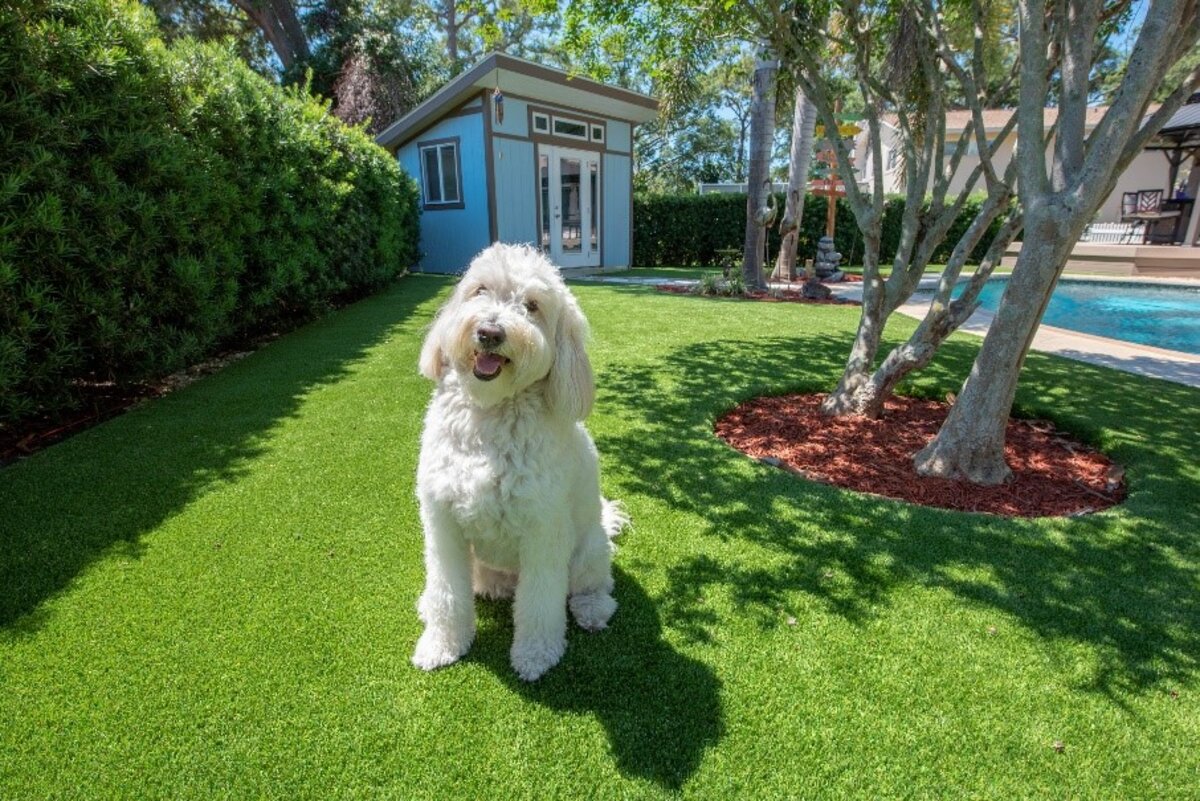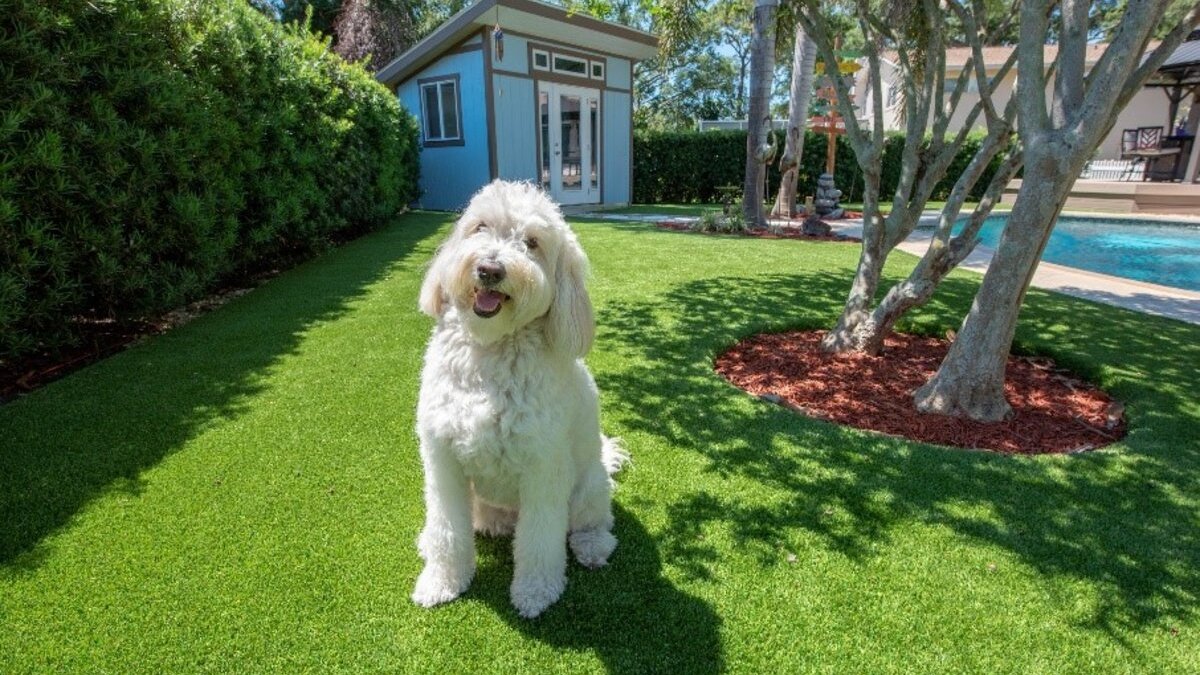
As a pet owner, you want to provide the best environment for your furry friend. If you’re considering installing artificial grass in your yard, you might be wondering: is artificial grass safe for pets?
This article will explore the pros and cons of artificial turf for pet owners, helping you make an informed decision about your outdoor space.
Understanding Artificial Grass
Before diving into the specifics of whether artificial grass is safe for pets, it’s important to first understand what artificial grass is and how it differs from natural grass. This foundational knowledge will help in evaluating its suitability for pet-friendly environments.
What is Artificial Grass?
Artificial grass, often referred to as synthetic turf, is a man-made surface that mimics the look and feel of natural grass. It is primarily used in sports fields, residential lawns, and commercial landscapes.
Unlike natural grass, it is made from synthetic fibers and is designed for durability and low maintenance, offering a practical solution for many outdoor areas.
Components of Artificial Grass
Artificial grass consists of several components that contribute to its functionality. The synthetic blades, usually made from materials like polyethylene or polypropylene, form the top layer. Beneath this, a backing material provides stability, while infill—often made from crumb rubber, sand, or cork—adds weight, cushioning, and helps the blades stand upright.
The Appeal of Artificial Grass for Pet Owners
Many pet owners find artificial grass an attractive option due to its practicality and low-maintenance nature. One of the biggest draws is that it requires far less upkeep than natural grass.
Pet owners can enjoy a clean outdoor space without worrying about mud or dirt being tracked into the house. Moreover, artificial grass doesn’t develop brown spots from pet urine, which can ruin the look of natural lawns. It’s also highly durable, making it ideal for dogs that like to dig or play hard.
But the question remains: is artificial grass safe for pets?
Safety Considerations for Pets on Artificial Grass
When determining if artificial grass is a safe option for pets, several important factors must be considered.
Material Toxicity
Most artificial grass is made from non-toxic materials. However, it’s important to note that some cheaper versions may contain harmful substances like lead.
To ensure the safety of your pets, always choose high-quality, pet-friendly artificial grass from reputable manufacturers. This guarantees that the materials used are safe and free from toxic chemicals.
Heat Retention
One of the drawbacks of artificial grass is that it can retain heat, becoming much hotter than natural grass on sunny days. This poses a risk of burning your pet’s paws or causing overheating.
To mitigate this issue, consider installing lighter-colored turf that reflects more sunlight, placing it in shaded areas, or watering the grass to cool it down before allowing your pets to play.
Bacteria Growth
While artificial grass doesn’t attract pests like natural grass, it can accumulate bacteria from pet waste if not properly cleaned. Regular maintenance, including cleaning up solid waste and using pet-safe cleaners, is essential to keep the environment hygienic and safe for pets. This helps prevent any health risks associated with bacterial buildup.
Ingestion Risks
Some pets, especially curious dogs, may attempt to chew or ingest artificial grass. Although most won’t consume enough to cause harm, it’s important to monitor your pet’s behavior and discourage them from chewing on the turf. If ingestion becomes an issue, consider consulting a vet or switching to a different surface material.
Allergies
In rare cases, pets may have allergic reactions to the materials used in artificial grass. Symptoms could include excessive scratching, redness, or irritation. If you notice these signs, consult with your veterinarian and consider switching to a different material that’s more suitable for your pet’s sensitivities.
Benefits of Artificial Grass for Pet Owners
Despite some safety concerns, artificial grass offers numerous advantages for pet owners that can make it a smart investment.
Easy Waste Management
One of the most practical benefits of artificial grass is how easy it is to manage pet waste. Solid waste can be removed with ease, while urine drains through the turf into the ground beneath, minimizing odors and preventing the formation of unsightly yellow spots that are common with natural grass.
Parasite Prevention
Unlike natural grass, artificial turf doesn’t provide a hospitable environment for fleas, ticks, and other parasites. This can significantly reduce the risk of infestations and improve your pet’s overall well-being, especially during warmer months when parasites thrive in natural lawns.
Durability
Artificial grass is highly durable, making it ideal for pets that love to dig or play rough. It can withstand heavy use without developing bare patches or muddy areas, ensuring that your lawn stays looking great even with active pets.
Consistent Surface
The even, stable surface of artificial grass is gentler on pets’ joints, especially for older animals or those with mobility issues. This makes it a safer and more comfortable option for pets to play and exercise.
Making Artificial Grass Safe for Pets
If you decide to install artificial grass, there are several steps you can take to ensure it’s as safe and comfortable as possible for your pets.
Choose Pet-Friendly Products
When selecting artificial grass, opt for products specifically designed for pet use. These types of turf often have better drainage and antimicrobial properties to help keep your pets safe and healthy.
Proper Installation
Ensuring proper installation is key to preventing issues like standing water or bacterial growth. Make sure the grass is installed with adequate drainage systems, and consider consulting a professional for a more thorough setup.
Regular Cleaning
Cleaning artificial grass regularly is crucial for maintaining a hygienic environment. A simple mixture of water and vinegar can be used to clean the surface, ensuring that pet waste is removed and bacteria don’t accumulate.
Monitor Temperature
On particularly hot days, always check the temperature of the artificial grass before allowing your pets onto the surface. Provide shade or cooling options like water to keep your pets comfortable and prevent overheating.
Introduce Gradually
If your pets are unfamiliar with artificial grass, it’s a good idea to introduce them gradually. Monitor their behavior to ensure they are comfortable and adjust as needed to ensure a smooth transition.
Alternatives to Artificial Grass for Pet Owners
If artificial grass doesn’t seem like the best fit for your pet, there are other alternatives to consider. Natural grass, particularly hardy pet-resistant varieties, maybe a better option.
Additionally, using mulch or wood chips in designated pet areas can provide a durable surface for pets to play on. Gravel or pebbles can also work well, and clover lawns offer a more resilient option than traditional grass.
Expert Opinions: Is Artificial Grass Safe for Pets?
To provide a balanced perspective, it’s useful to consider what experts have to say about the safety of artificial grass for pets.
Veterinarian Perspective
Dr. Sarah Johnson, DVM, notes, “While artificial grass can be safe for pets when properly maintained, it’s important to monitor your pet’s interaction with the surface and address any issues promptly. Regular cleaning is essential to ensure a healthy environment.”
Landscaping Expert View
Professional landscaper John Smith adds, “High-quality, pet-specific artificial grass can be a great option for pet owners. However, it’s not a completely maintenance-free solution. Regular cleaning and proper installation are key to keeping the turf safe and durable.”
Case Studies: Pets and Artificial Grass
Let’s explore some real-life examples of how pets have adapted to using artificial grass in different households.
1. The Active Dog
Max, a 3-year-old Labrador, has been using artificial grass in his yard for over a year. His owner reports no health issues and appreciates the easy maintenance, particularly after rainy days when mud would have been a problem with natural grass.
2. The Senior Cat
Whiskers, a 12-year-old indoor-outdoor cat, adapted well to her new artificial grass enclosure. Her owner noticed less tracking of dirt indoors and found it easier to spot and clean up any accidents, making the switch a convenient choice.
3. The Multi-Pet Household
The Johnson family, with two dogs and three cats, installed artificial grass in their backyard. They found it easier to maintain with multiple pets, though they did have to replace a small section after one of their dogs developed a habit of chewing on the turf. Overall, the installation improved cleanliness and reduced yard upkeep.
Conclusion
After considering the pros and cons, the question remains: is artificial grass safe for pets? The answer is that it can be, with proper selection, installation, and maintenance.
High-quality, pet-friendly artificial grass can provide a durable, low-maintenance outdoor space for you and your furry companions to enjoy.
By making an informed decision and taking proper precautions, you can create a safe and enjoyable outdoor space for your pets, whether you choose artificial grass or another option. Your pets’ health and happiness should always be the top priority in any home improvement decision.
Olivia Foster
Related posts
Stay connected
Today's pick
- Safety Essentials Every CNC Operator Should Follow DailyCNC machining demands precision, consistency, and discipline—but above all, it requires strict attention to safety. Whether you’re working with mills, lathes, routers, or grinders, every machine has the potential to cause serious injury if mishandled. That’s why CNC operators must follow safety protocols daily, no... The post Safety Essentials Every CNC Operator Should Follow Daily […]

